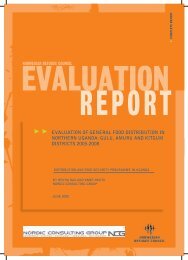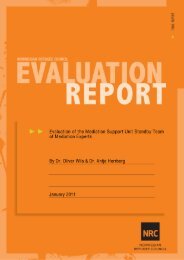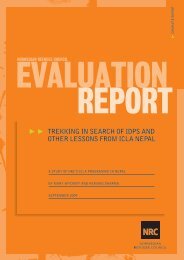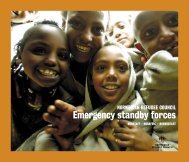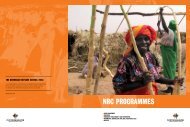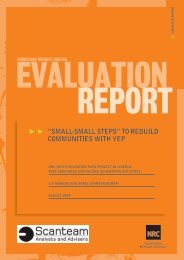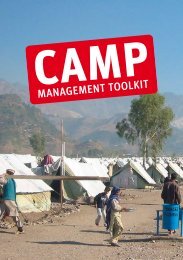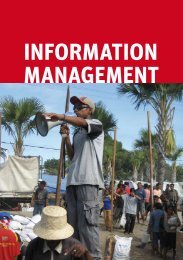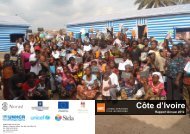Download full report - English version - ProAct Network
Download full report - English version - ProAct Network
Download full report - English version - ProAct Network
You also want an ePaper? Increase the reach of your titles
YUMPU automatically turns print PDFs into web optimized ePapers that Google loves.
Photo B3 : Permanent structure near Giterany<br />
Latrines. The latrines visited at the school sites were ventilated improved pit (VIP)<br />
latrines and permanent structures. VIP latrines offer improved sanitation conditions by<br />
eliminating flies and odours through better ventilation systems: the addition of a<br />
chimney draws air into the structure. In this instance, the depth of the pits was 7m and<br />
they were not designed to be emptied. The volume of waste reduces naturally during<br />
the dry season, making them a viable option in this situation. The latrines visited were<br />
adequately sited by the local administration.<br />
Photo: Permanent latrine structure, Giterany Camp<br />
Additional Observations:<br />
The siting of NRC classrooms and latrines is done by the local administration.<br />
Furniture for all classrooms is purchased locally and made from Grevillea wood.<br />
Adobe bricks are made by excavating local soils that have some clay content and<br />
removing the first 50-100cm of topsoil, which is discarded. The bricks are then<br />
compressed manually with wooden blocks and left to dry for five days.<br />
Several open pits resulting from the excavation of soil for adobe bricks were<br />
observed around the classrooms. These are a potential hazard, particularly if they<br />
fill with water as they become potential reservoirs for disease carrying vectors<br />
such as mosquitoes. Children and small animals can also easily fall into such<br />
voids.<br />
Local contractors are used to supply local materials, which are screened for quality<br />
control. Contractors are also responsible for recruiting and paying for manpower.<br />
NRC consistently checks wood supplier certificates to ensure that the timber is<br />
from legal sources.<br />
No water facilities or rainwater collection structures were observed near the semipermanent<br />
and permanent classrooms visited.<br />
All structures appeared to have adequate drainage channels.<br />
3.4.2 Resettlement Area<br />
The Mission made a field visit to a resettlement area, where returning Burundians are<br />
currently establishing their homes. NRC is involved in this process through the<br />
provision of materials and labour for the construction of family homes to returnees and<br />
vulnerables. The homes are basic 5m x 7m structures made of adobe bricks,<br />
Eucalyptus poles, a Grevillea door and window frames and iron sheets. The<br />
beneficiaries contribute to the construction of their homes by digging latrine pits,<br />
making the bricks and helping the mason hired by NRC.<br />
30




